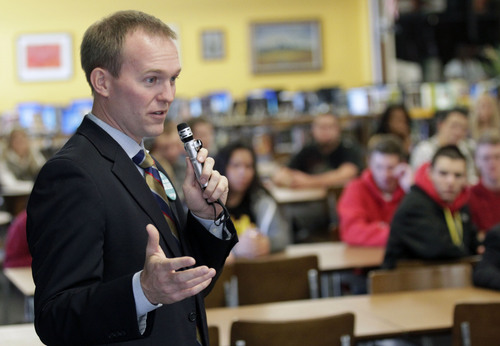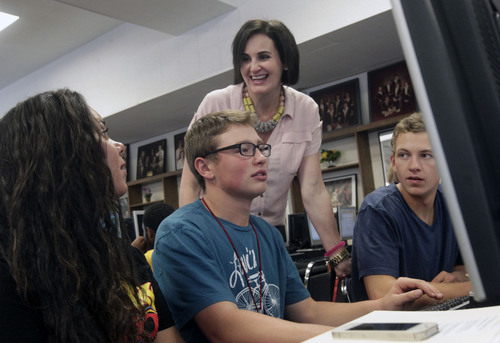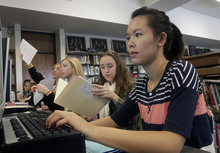This is an archived article that was published on sltrib.com in 2013, and information in the article may be outdated. It is provided only for personal research purposes and may not be reprinted.
Camila Gramondi has been working toward college since the seventh grade, and the 18-year-old knows why she wants a business degree.
"[I've] just [seen] my parents struggling so much because they didn't have a college education," said Gramondi, a senior at Cottonwood High School.
But there's still plenty of work ahead to finish up, between high school classes, extracurricular activities and work. On Monday she tackled the next big step: the college application.
"It's our senior year, we're so close and it's nerve-racking!" said Ivett Gonzalez, a 17-year-old aspiring teacher.
About 60 Cottonwood High students, many of them low-income or prospective first-generation college students, came to the school library for help with that all-important but often complex first step. It's part of College Application Week, a new effort led by the Utah System of Higher Education to give students, especially those from underserved groups, guidance on accessing college.
"We have parents come in and they don't even know how to begin," said Martha Camarillo Freston, a college access advisor for Utah College Advising Corps.
Higher education officials are hoping to close a sizable gap that seems to open up between middle school and high school graduation: While more than 90 percent of middle school students say they want to go to college, only about 54 percent of graduates immediately enroll in higher education, according to USHE. That rate drops to 41 percent for low-income students.
USHE is working with eight Wasatch Front schools in three districts to set aside time during the school day to fill out applications, provide advisors to help and offer application fee waivers for low-income students.
"We're getting at the school level, and bringing administration, faculty and staff on board," said Melissa Miller Kincart, assistant commissioner for outreach and access at USHE.
Most college applications are available online, but the process is far from self-explanatory. Gramondi, for example, paused while typing her high school courses onto a form for the University of Utah application.
"What does this mean when it says 'college algebra?' " she asked Freston.
"Do you remember taking algebra at all?" Freston said, and flipped open Gramondi's transcript, which was printed and prepared for all the students at the event.
"Yep," she said, telling Gramondi her high school course fills the requirement.
Freston is hoping to help every graduating senior at Cottonwood High apply to at least one college — usually, less than half of the 450 graduating seniors apply, school officials said. The process has changed significantly over the last two decades, Salt Lake County Mayor Ben McAdams told the Cottonwood High students.
"I didn't know how the application process worked," he said. "I kind of knew I needed the take the ACT."
He signed up to take the test, but cracked the books to study only once — and then left in a hurry when friends invited him to a haunted house.
McAdams ended up at Weber State University and transferred to the University of Utah, where he began his political career as president of the student body, and later went to Columbia Law School in New York. He paid for his education with Pell Grants and student loans, scrounging entertainment money from the occasional donation trip to the blood bank.
"A college education is accessible to you and it's a door to a bright and prosperous future," he said. "Sometimes it's a leap of faith, but if you believe in yourself you can succeed."







